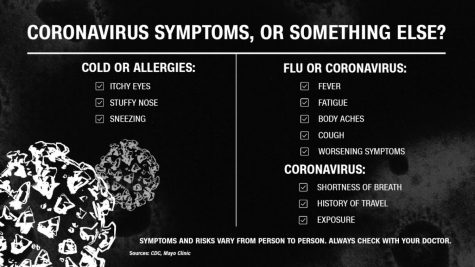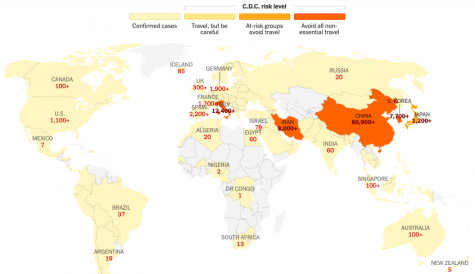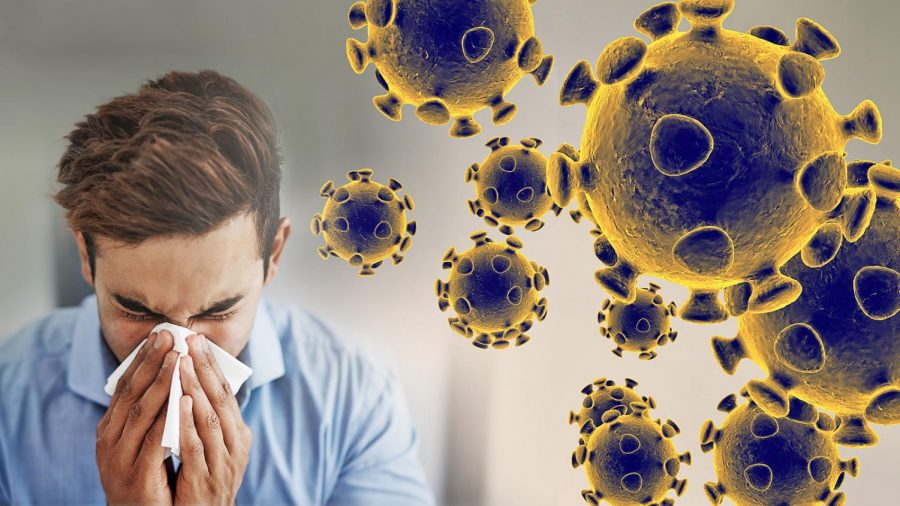The coronavirus in a nutshell
March 11, 2020
On December 31st, 2019, China reported numerous pneumonia cases in people linked to the Chinese Huanan Seafood Wholesale Market. As the number of these cases skyrocketed, Chinese health authorities finally confirmed that this was caused by a novel coronavirus, COVID-19.
What is the coronavirus?
Coronaviruses are a group of common viruses. The virus obtains its name for the crown-like spikes on the surface. A handful of coronaviruses only infect animals, but others can also infect humans.
A novel coronavirus has been defined by The Centers for Disease Control and Prevention (CDC) as a new strain of virus that has not been previously identified in humans. On February 11, 2020 the World Health Organization (WHO) formally announced an official name that is causing the current outbreak of the coronavirus disease: COVID-19. In COVID-19, ‘CO’ stands for ‘corona,’ ‘VI’ for ‘virus,’ ‘D’ for disease and the ‘19’ for the year of 2019.
 Where did the coronavirus start?
Where did the coronavirus start?
The COVID-19, also simply known as the coronavirus, was first observed in Wuhan, China. Like many other coronaviruses, it arises from many different species of animals, including camels, cattle, bats and cats. Many of those initially infected either worked or frequently visited the Huanan Seafood Wholesale Market in China, which sold live and newly slaughtered animals.
As of today, public health officials are still working hard to identify the exact original animal source of the virus. Analysis of the genetic tree indicates that the virus emerges from bats, however, no bats are sold at the seafood market. This suggests that an unidentified animal served as an intermediary host to transmit the virus to humans.
Also, a study from Live Science proposes snakes, which are sold at the seafood market, as a possible source of the new virus. Yet, some experts criticize the study, saying it is unclear whether or not coronaviruses can infect snakes.
What does the coronavirus do to the body?
Most commonly, the coronavirus only results in mild common cold symptoms, including a runny nose, sore throat, cough and fever. However, it can be more severe for some people and can lead to pneumonia or breathing difficulties. It is estimated that symptoms may appear as soon as two days or as long as 14 days after exposure. More rarely, the disease can be fatal. The WHO says it can inflict serious diseases, like the Severe Acute Respiratory Syndrome (SARS) and the Middle Eastern Respiratory Syndrome (MERS).
How does the coronavirus spread?
The virus is thought to spread mainly from person-to-person. The CDC  explains that the virus can transfer between people who are in close contact with one another (within about six feet). It can also spread via respiratory droplets produced when an infected person coughs or sneezes. Older people and those with pre-existing medical conditions, such as diabetes and heart disease, appear to be more susceptible to becoming ill with the virus.
explains that the virus can transfer between people who are in close contact with one another (within about six feet). It can also spread via respiratory droplets produced when an infected person coughs or sneezes. Older people and those with pre-existing medical conditions, such as diabetes and heart disease, appear to be more susceptible to becoming ill with the virus.
Are there treatments for the coronavirus?
There are no specific treatments for coronavirus infections and most people will recover on their own. This recovery involves rest and medication to alleviate the symptoms. Currently, there is no vaccine for the new coronavirus, but researchers globally, including the U.S. National Institutes of Health, recently confirm that they are in the preliminary stages of developing one.
Should one be worried about the coronavirus?
 By now, it is known that the coronavirus is not a new phenomenon. In fact, most people get infected with human coronaviruses at some time in their life. Currently, CNN says there are at least 149 known cases in the United States. That figure includes people diagnosed through the US public health system, and people repatriated to the US. However, at this time, the greatest risk of infection is for people who reside in or recently traveled to China, or those who have been in close contact with an infected individual. Regardless, health precautions should still be taken.
By now, it is known that the coronavirus is not a new phenomenon. In fact, most people get infected with human coronaviruses at some time in their life. Currently, CNN says there are at least 149 known cases in the United States. That figure includes people diagnosed through the US public health system, and people repatriated to the US. However, at this time, the greatest risk of infection is for people who reside in or recently traveled to China, or those who have been in close contact with an infected individual. Regardless, health precautions should still be taken.
After all, there is more to understand about COVID-19’s transmissibility, severity and other features. Since this strain of coronavirus has never been encountered before, there are still additional factors that are not yet known, but researchers are working on obtaining more information on this emerging disease.

For live updates of the coronavirus, visit this link: https://ourworldindata.org/coronavirus































